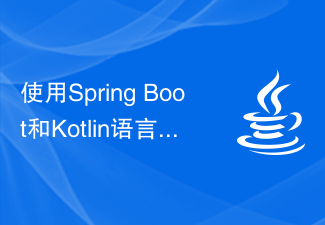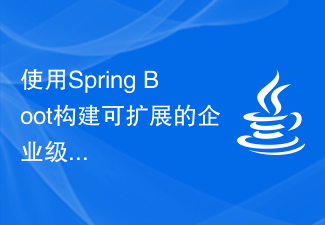 Backend Development
Backend Development PHP Tutorial
PHP Tutorial Discussion on PHP SSO single sign-on solution for enterprise-level applications
Discussion on PHP SSO single sign-on solution for enterprise-level applications
Discussion on PHP SSO single sign-on solution for enterprise-level applications
With the increasing number of enterprise-level applications, users are no longer satisfied with using a single application for work. and life. Instead, they want to be able to integrate multiple apps and log in once to access all associated apps. In this case, single sign-on (SSO) becomes a very important solution, which can provide a seamless method of user authentication and access control.
In the field of PHP development, there are many feasible SSO implementation solutions. This article will discuss a PHP SSO single sign-on solution for enterprise-level applications and provide specific code examples.
First of all, we need to clarify the basic principles of SSO. SSO implements single sign-on by using a central authentication mechanism. In this mechanism, the user only needs to log in once, and during subsequent visits, all related applications will share the user's login status. After the user is authenticated, an encrypted Token will be generated on the server and then passed to other associated applications through cookies, URL parameters, etc.
In our PHP SSO solution, we will use Token-based authentication. The following are the basic steps of the solution:
- Create the Auth Center application: The Auth Center application is responsible for processing the user's login request and generating Token. The application is also responsible for verifying Tokens sent by other associated applications to ensure the legal identity of the user.
- Create an associated application (Sub App): The associated application is responsible for checking the user's login status and passing relevant information to the certification center. When the user accesses the associated application, the application will detect whether there is a valid Token. If not, it will be redirected to the certification center for authentication.
The following is a simple PHP code example that demonstrates how to pass Token between the certification authority and the associated application.
Auth Center application code example:
<?php
// 在该应用中处理用户的登录请求并生成Token
// 检查用户的用户名和密码
function checkUserCredentials($username, $password) {
// 假设这里进行了一些身份验证逻辑
// 如果验证通过,返回用户ID,否则返回false
}
// 生成Token
function generateToken($userId) {
// 使用用户ID和当前时间戳生成Token
// 这里可以使用加密算法对Token进行签名
return $token;
}
// 处理登录请求
if ($_SERVER['REQUEST_METHOD'] === 'POST') {
$username = $_POST['username'];
$password = $_POST['password'];
$userId = checkUserCredentials($username, $password);
if ($userId) {
$token = generateToken($userId);
// 将Token存储在服务器中,以便其他应用验证
// 并将Token发送给关联应用
} else {
// 登录失败
}
}
?>Associated application (Sub App) code example:
<?php
// 检查用户的登录状态,如果不存在有效的Token,则将用户重定向到认证中心
// 检查Token是否有效
function checkToken($token) {
// 这里可以对Token进行解密和验证
// 如果Token有效,返回用户ID,否则返回false
}
// 获取Token
function getToken() {
// 从Cookie、URL参数等方式中获取Token
}
// 获取关联应用的URL
function getAppUrl() {
// 返回认证中心的URL
}
// 检查用户的登录状态
function checkLoginStatus() {
$token = getToken();
if ($token) {
$userId = checkToken($token);
if ($userId) {
// 用户已登录,继续访问
} else {
// Token无效,重定向到认证中心
header('Location: ' . getAppUrl());
exit();
}
} else {
// Token不存在,重定向到认证中心
header('Location: ' . getAppUrl());
exit();
}
}
// 在关联应用的入口处调用checkLoginStatus()函数
?>The above code example is just a simple demonstration, actual application More complex logic and security measures may be required. In addition, other technologies and tools can be used to enhance the functions and performance of SSO, such as using encryption algorithms to protect tokens and using single sign-out to implement the logout function.
In short, the PHP SSO single sign-on solution for enterprise-level applications can greatly improve user experience and work efficiency. By using a certificate authority, users only need to log in once to access all associated applications. The code example provided in this article serves as a basic implementation method and can be expanded and optimized according to specific needs. I hope this article can help readers understand the basic principles of SSO and provide a feasible solution for the development and architecture of enterprise-level applications.
The above is the detailed content of Discussion on PHP SSO single sign-on solution for enterprise-level applications. For more information, please follow other related articles on the PHP Chinese website!
 使用Java框架开发企业级应用的最佳实践Jun 04, 2024 am 11:51 AM
使用Java框架开发企业级应用的最佳实践Jun 04, 2024 am 11:51 AM在构建Java企业级应用程序时,最佳实践包括:选择合适的框架、应用分层架构、使用依赖注入、利用持久化框架、实施RESTfulAPI、实践安全最佳实践、重视单元测试。电子商务网站实战案例展示了这些实践的应用方式,为企业级开发提供了可行的指南。
 面向企业级应用的PHP SSO单点登录解决方案探讨Oct 15, 2023 pm 02:54 PM
面向企业级应用的PHP SSO单点登录解决方案探讨Oct 15, 2023 pm 02:54 PM面向企业级应用的PHPSSO单点登录解决方案探讨随着企业级应用的日益增多,用户不再满足于使用单个应用进行工作和生活。相反,他们希望能够集成多个应用,并且只需登录一次,即可访问所有关联的应用。在这种情况下,单点登录(SSO)就成为了一个非常重要的解决方案,它可以提供一种无缝的用户认证和访问控制方式。在PHP开发领域,有许多可行的SSO实现方案。本文将探讨一种
 Vue.js与ASP.NET的结合,实现企业级应用的开发和部署Jul 29, 2023 pm 02:37 PM
Vue.js与ASP.NET的结合,实现企业级应用的开发和部署Jul 29, 2023 pm 02:37 PMVue.js与ASP.NET的结合,实现企业级应用的开发和部署在当今快速发展的互联网技术领域,企业级应用的开发和部署变得越来越重要。Vue.js和ASP.NET是两个在前端和后端开发中广泛使用的技术,将它们结合起来可以为企业级应用的开发和部署带来诸多优势。本文将通过代码示例介绍如何使用Vue.js和ASP.NET进行企业级应用的开发和部署。首先,我们需要安装
 Java框架在企业级应用中的性能优化实战Jun 02, 2024 pm 12:17 PM
Java框架在企业级应用中的性能优化实战Jun 02, 2024 pm 12:17 PM如何利用Java框架在企业级应用中进行性能优化?缓存技术:使用Ehcache、Caffeine等框架缓存经常访问的数据,减少数据库访问次数。延迟加载:启用hibernate.enable_lazy_load_no_trans属性,避免预先加载所有数据,只在需要时加载。线程池优化:使用Executors框架创建线程池管理线程,确保高并发场景下系统稳定运行。代码优化:遵循最佳实践,避免过度创建对象、使用合适的数据结构、及时释放资源。
 使用Spring Boot和Kotlin语言实现企业级应用Jun 23, 2023 am 09:15 AM
使用Spring Boot和Kotlin语言实现企业级应用Jun 23, 2023 am 09:15 AM随着企业级应用的需求不断增加,各种新技术也层出不穷。然而,随着Java技术的发展,越来越多的开发者开始关注Kotlin语言。Kotlin是一门由JetBrains开发的静态类型编程语言,为基于JVM的应用提供了更简洁、安全且易读易写的代码,也因此在开发中体现出更强的生产力。同时,SpringBoot也因其轻量级、快速构建、简单可配置的特性,成为了企业级应用
 PHP 企业级应用源码管理与协作May 08, 2024 pm 01:09 PM
PHP 企业级应用源码管理与协作May 08, 2024 pm 01:09 PMPHP企业级应用源码管理与协作在现代软件开发中,有效管理和协作处理代码至关重要。本文将介绍如何使用Git来管理企业级PHP应用程序的源码,并提供一个实战案例演示其协作流程。Git简介Git是一个分布式版本控制系统,允许开发人员跟踪代码更改、协作处理分叉和合并更改。以下是Git的关键概念:仓库:包含应用程序代码的中央存储库。本地副本:开发人员机器上的仓库克隆。提交:对仓库所做的更改集合,带有时戳和提交说明。分叉:从仓库创建的独立副本,用于在不影响主分支的情况下进行更改。合并:将更改从分叉合
 使用Spring Boot构建可扩展的企业级应用Jun 22, 2023 pm 04:31 PM
使用Spring Boot构建可扩展的企业级应用Jun 22, 2023 pm 04:31 PM在开发企业级应用程序时,可扩展性是至关重要的。企业级应用程序需要能够处理大量的业务逻辑和数据,并且需要随着需求的变化不断地增加新功能。SpringBoot是一个流行的Java框架,可以帮助开发人员构建可扩展的企业级应用。本文将探讨如何使用SpringBoot构建可扩展的企业级应用程序,包括以下主题:SpringBoot简介构建可扩展的企业级应用的最佳实
 企业级应用开发中的应用与实践:使用Spring框架Jan 24, 2024 am 08:51 AM
企业级应用开发中的应用与实践:使用Spring框架Jan 24, 2024 am 08:51 AMSpring框架在企业级应用开发中的应用与实践引言:随着信息技术的不断发展,企业级应用开发变得越来越复杂。为了加快开发速度、提高系统稳定性和可扩展性,开发人员需要借助一些优秀的开发框架。Spring框架作为一个开源的轻量级应用开发框架,经过多年的发展已经广泛应用于企业级应用开发中。本文将介绍Spring框架在企业级应用开发中的应用与实践,并提供一些具体的代码


Hot AI Tools

Undresser.AI Undress
AI-powered app for creating realistic nude photos

AI Clothes Remover
Online AI tool for removing clothes from photos.

Undress AI Tool
Undress images for free

Clothoff.io
AI clothes remover

AI Hentai Generator
Generate AI Hentai for free.

Hot Article

Hot Tools

EditPlus Chinese cracked version
Small size, syntax highlighting, does not support code prompt function

Safe Exam Browser
Safe Exam Browser is a secure browser environment for taking online exams securely. This software turns any computer into a secure workstation. It controls access to any utility and prevents students from using unauthorized resources.

Dreamweaver CS6
Visual web development tools

SublimeText3 Linux new version
SublimeText3 Linux latest version

mPDF
mPDF is a PHP library that can generate PDF files from UTF-8 encoded HTML. The original author, Ian Back, wrote mPDF to output PDF files "on the fly" from his website and handle different languages. It is slower than original scripts like HTML2FPDF and produces larger files when using Unicode fonts, but supports CSS styles etc. and has a lot of enhancements. Supports almost all languages, including RTL (Arabic and Hebrew) and CJK (Chinese, Japanese and Korean). Supports nested block-level elements (such as P, DIV),





